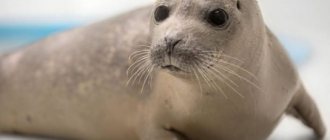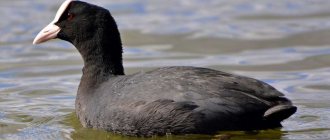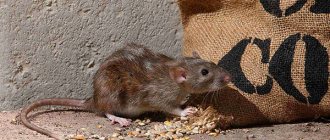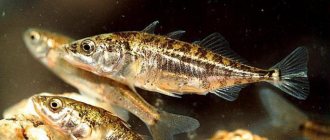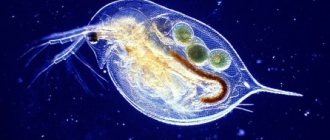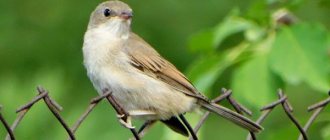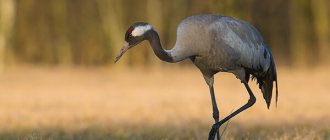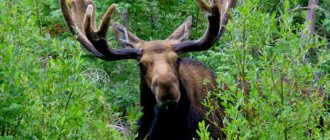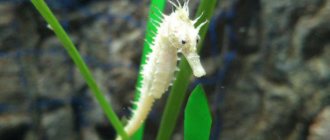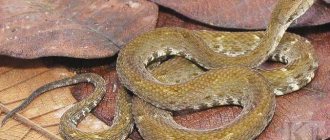The Caspian seal (Phoca caspica) is a representative of the family of true seals, the only marine mammal in the fauna of the Caspian Sea.
Caspian seals (these animals are also called Caspian seals) got their name due to their habitat. This species is distributed throughout the Caspian Sea, sometimes entering the rivers flowing into it. In winter and spring, during breeding and molting, the main part of the herd concentrates in the northern regions of the sea on floating ice. In the spring, when the ice begins to melt, some seals leave the shallow, well-warmed northern part of the sea and migrate south.
Most of the population spends the summer in the southern and middle Caspian regions, while some of the herd remains in the northern regions. As the breeding season approaches, seals migrate again to the northern regions.
Appearance
This animal has a spindle-shaped and fluffy body, the length of which is 130-150 cm. The weight of an individual can vary from 40 to 80 kg. Sexual dimorphism is expressed in size and color: males are slightly larger than females, their hair is darker.
The Caspian seal has almost no neck, it is very short. The animal's head is small, the skull is flattened. The seal does not have ears; instead, the predator has auditory canals that are invisible. The eyes of these mammals are black and quite large. They are covered by a shroud during the dive. On land they often tear up. These predators have a thick fat layer, which allows them to easily endure cold weather and lack of food. The seal's skin is durable and covered with thick hair. The color of adult individuals is usually off-white, with almost green fur on the back.
There are membranes between the seal's toes. On the forelimbs of animals there are strong claws that help create holes - they are needed to get out onto land.
Description of the seal
The Caspian seal (photo of an adult is shown below) is a small species. In adulthood, its body length is on average 1.20-1.50 m, and its weight is 70-90 kg. Despite their short stature, they are quite thick and their heads are small. There is a mustache. The eyes are large and dark in color. The neck, although short, is noticeable. The front five-fingered limbs are short and have strong claws. The coat is very smooth and shiny.
The coloring of these seals depends on their age. But in adult individuals the main tone is a dirty straw-whitish color. The back is olive-gray in color and covered with dark irregular spots; the color transition from the belly to the back is smooth. Although the color may be slightly different shades. Males seem more contrasting than their companions. They are also slightly larger than females and are distinguished by a more massive head with an elongated muzzle.
Where does it live?
Caspian seals inhabit the coasts of the Caspian Sea; their habitat is located in Iran. The species is practically not represented on the southern shores of the sea. Individuals migrate frequently. So, at the beginning of winter they move to the glaciers located in the north of the Caspian Sea. By the end of winter, these temporary habitats begin to melt, at which time the seals move to the southern coasts of this sea. There is always a lot of food here, this helps the animals build up their fat layer. In spring and summer, these predators can swim to the mouth of the river. Volga. They love to drift on ice floes. In winter, seals spend most of their time in the water, and in summer they rest on land.
underwater life
The Ladoga seal feels better in water, even cold water, than on land. Her elongated body is specially adapted for active swimming. In addition, flippers help her with this. The thick layer of subcutaneous fat and the fact that the fur does not get wet prevents it from freezing. Having deftly dived to a depth of 300 meters, the seal can hold its breath for 40 minutes. This is possible due to the fact that her body is able to slow down its metabolism, and, therefore, it requires less oxygen. Moreover, vital organs are intensively supplied with blood: the head, liver and brain. The seal's endurance allows it to swim several tens of kilometers at a speed of 20 km/hour.
What does it eat?
The Caspian seal eats many types of fish: sprat and herring, sand broadhead. The animal also feeds on shrimp and amphipods, but the favorite predator is gobies. Sometimes the mammal eats small representatives of invertebrates. Crustaceans are not very popular among seals.
To find food, the animal dives under water. It can swim for kilometers before finding prey. The maximum depth to which a seal dives is 85 m. An adult consumes 3-6 kg of fish per day. The prey is digested in 2 to 4 hours.
Meaning for humans
Seals are subject to industrial production. They are hunted by local residents for meat and skins, from which they make clothes and shoes. Seals play a special role in the world around them. They are very important for humans and the environment.
Pinnipeds are a link in the food chain. They eat a lot of fish and other sea creatures. Due to this, the number of species is regulated and a lot of plant food is preserved.
Lifestyle
The animal spends almost its entire life under water. Caspian seals are excellent swimmers thanks to their small round heads and spindle-shaped body. Therefore, the predator can stay in the water for about 1.5 hours. Seals often sleep on the water.
In winter, Caspian seals rarely appear on land and do this only to take in air. They have rookeries where animals come during the mating season.
Predators have a good sense of smell and vision. They are very distrustful and always cautious. Danger may await on land and, if this happens, the individual quickly swims away.
Caspian seals are loners. These animals create flocks only during the breeding season, but even then they are a little shy of their relatives.
general characteristics
The average body length of an adult seal is 165 cm (from the end of the nose to the end of the hind flippers). Weight from 50 to 130 kg, females are larger than males. Linear growth ends by the age of 17-19, and weight growth continues for a number of years and is possible until the end of life. Seals live up to 55 years.
In a calm environment, the speed of movement under water does not exceed 7-8 km/h. She swims at greater speed when she moves away from danger. On a hard surface, the seal moves quite slowly, moving with its flippers and tail. In case of danger, he jumps.
According to fishermen, seals have been caught in nets at depths of up to 200 m, but, as a rule, they dive to much shallower depths. The Baikal Limnological Museum of the Institute of Science and Technology SB RAS contains information that seals live at a depth of up to 300 meters. It finds food in a well-lit area (25-30 m) and apparently does not need to dive deep. Nerpa is capable of diving up to 200 m and can withstand pressure of 21 atm. In nature, it stays under water for up to 70 minutes - this is enough for it to get food or escape from danger.
Reproduction
These animals become sexually mature only at 6 or 7 years of age. Males can have offspring later. Females usually give birth every year or every 2 years. Approximately 10% of females do not become pregnant after the end of the breeding season.
The breeding season starts in the spring. The female carries the cub for 10 to 11 months. They give birth to their offspring right on the glaciers. At this time, females are especially vulnerable. One female gives birth to 1-3 puppies weighing 5 kg and length 65-79 cm. At birth, the cubs are covered with white fur - they are called puppies. At first, the mother feeds them with milk, but at 2-4 months this period ends.
Females are well prepared for the birth of babies. They create shelters from the snow where they raise their young. Then the mother switches the cubs to an adult diet. Even before this, the squirrels’ fur changes color. Males have no contact with their pups.
Notes
- Systematics and synonymy (English). BioLib. Retrieved January 16, 2011.
- Pusa sibirica
Archived June 4, 2010. in Wilson DE & Reeder DM (editors). 2005. Mammal Species of the World. A Taxonomic and Geographic Reference (3rd ed.). — Baltimore: Johns Hopkins University Press, 2 vols. (2142 pp.) ISBN 978-0-8018-8221-0 - Sokolov V. E.
Five-language dictionary of animal names. Mammals. Latin, Russian, English, German, French. / under the general editorship of academician. V. E. Sokolova. - M.: Rus. lang., 1984. - P. 112. - 10,000 copies. - ↑ 123
Baikal seal on the website https://zooex.baikal.ru - Focus on the Baikal seal on the website https://www.globalnature.org
- Nerpa is a mammal of Lake Baikal
- Kutyrev I. A., Pronin N. M. Passport of the Baikal seal // Baikal seal: Passport and bibliography / RAS. Siberian department. Institute of General and Experimental Biology. Compiled by: I. A. Kutyrev, N. M. Pronin, L. S. Imikhelova, E. A. Petrov, E. A. Kuzmina. Rep. Ed.: T. P. Doboeva, S. G. Shchepin. - Ulan-Ude, 2006. - pp. 9-11.
- Baikal seal
- Pastukhov V.D. Nerpa of Baikal. - Novosibirsk: Nauka, 1993. - 271 p.
- “Characteristics and industrial use of the liver of the Baikal seal for food purposes”
- Study of the composition of Baikal seal fat and development of ways to use it
- "Red Book of the Russian Federation (animals)". ed. "Astrel" 2001. pp. 6,845,860
Natural enemies
Caspian seals have many natural enemies. Often it is the pups and their mothers who become the prey of these predators. Defenseless seals are attacked by foxes and wolves, killer whales and brown bears, and sharks. Sometimes, when walruses have no choice at all, they attack Caspian seals.
Humanity causes enormous harm to populations of this species. At the moment, poaching is rampant and animal habitats are being polluted. Because of this, the number of Caspian seals is constantly declining.
Continuation of the family line
Most females whelp in late January - early February. Nursery breeding grounds of seals are formed in the northeastern part of the ice massif and in areas located to the north or northwest of Kulaly Island.
During the pup period, females form holes (holes), as the waterways quickly freeze together due to the absence of strong tidal currents and snow cover, as well as the low salinity of the water. The presence of holes is a characteristic feature of seal breeding grounds in the Caspian Sea. The concentration of animals in the rookeries does not reach a high density; seals are usually located on hummocky fields at a considerable distance from each other.
Red Book
This species is listed in the International Red Book. Caspian seals are considered to be endangered. The population decline began in the 1970s, and in 1975 the population was halved. Now the law prohibits killing more than 50 thousand mammals per year, but this could lead to the extinction of animals.
Why do they disappear
In recent years, the Ladoga seal has become an animal whose population is rapidly declining. The Red Book of Russia has already included it in its list. This is mainly due to human extermination. Previously, 20-30 thousand individuals lived in Lake Ladoga, but currently only 2-3 thousand seals live in it. The skin, fat, and meat of this animal are valuable, so they hunt it, but not on an industrial scale.
In the 20th century, the extermination of seals was not controlled, but today this is handled by the state fishery inspection. Fishing limits have been set. The destruction of the seal is also justified by the fact that it eats valuable species of fish in the lake. And this is despite the fact that scientists have proven that because of the small mouth, the seal in Lake Ladoga cannot eat large prey, which means that the population, for example, of salmon, has not decreased because of it. Opponents argue that these mammals eat fish caught in a net, since they do not need to swallow it, but only tear it off piece by piece, which they sometimes do for fun.
Interesting Facts
- The Caspian seal sleeps soundly. Often, scientists swam up to the sleeping predator and turned it over, but the seal continued to sleep.
- These animals have an interesting ability: they can delay and then resume fetal development. This ability is caused by necessity: in harsh winters, if babies are born, they will not survive.
- The age of the Caspian seal can be determined by the number of circles on its claws.
- Caspian seals are quite energetic animals. They can swim at a speed of about 30 km/h. They move on land using their tail and front flippers, moving them in turns.
- Zoologists believe that when living in good conditions and an abundance of food, animals can live 50 years. But today life expectancy is 15 years. The individual grows up to 20 years of age, but many die before even reaching middle age.
- The ancestors of the Caspian seals existed in the Tertiary period, but instead of flippers they had paw-like limbs.
Oil and poachers
The Caspian Sea lies on hydrocarbon deposits. According to Dmitry Glazov, there are various types of constant natural oil seepage, but this is a long-term and distributed effect on the sea ecosystem, and the Caspian has adapted to this. The impact of the anthropogenic factor leads to burst emissions, which are especially dangerous.
In the Caspian Sea, deep oil wells are being actively developed, artificial islands are being built to extract oil, which in this region is characterized by high sulfur content and, as a result, causticity. In the event of a powerful oil release, when a well is opened, all living things around die, it is impossible to adapt to this, plankton and fish will die, and the entire ecosystem will be undermined.
Hunting for seal pups (whites) is prohibited all over the world: Germany, Great Britain, France and other EU countries speak out against seal hunting. Only Denmark and Canada support hunting, due to their adherence to ancient customs that are part of the way of life of the indigenous people of the Canadian Arctic and Greenland.
In Russia, a ban on hunting these animals under one year of age was introduced in 2009. That same year, Seal Day was established, a holiday celebrated by the international environmental community on March 15, the approximate day on which seal pups are born.
Miragli Baimukanov agrees that oil production potentially poses the most serious risks for the fauna of the Caspian Sea, but also recalls the general deterioration in the quality of sea water: “Pollution of water bodies can be a serious threat to the conservation of species. Especially in the Caspian Sea. This is a body of water that has no flow. Everything that accumulates and flows from a huge pool, everything accumulates in the sea, on the bottom and in the water. This has a huge negative impact on all biodiversity. That is, in addition to the threat of direct death, if some kind of oil spill occurs and there is an environmental disaster that will lead to the immediate destruction of many species, there are also indirect reasons - the accumulation of toxicants in the body of animals, which leads to impaired immunity and a reduction in offspring , and to diseases."
Caspian seals on an island in the northern part of the Caspian Sea. Photo: Institute of Ecology and Evolution named after A.N. Severtsov RAS
Speaking about the state of the seal’s food supply, which can be negatively affected by invasive species, scientist Glazov notes that this animal, in terms of food, “is quite plastic and switches from one species to another, more accessible one.”
“If it had specialized in a particular species, such as sprat, then the decline in the seal population would have occurred much earlier, simultaneously with the decline in the sprat population,” he says. “During the sprat fishery, our fellow ichthyologists recorded its catch on video, and the footage often shows how the seal is spinning next to the sprat and does not touch it, but catches those predators that are attracted by a large number of sprat, for example, herring.”
At the same time, both researchers recall the detrimental impact of fishing on the seal population. “Those nets that are in the Caspian Sea, seals get caught in them and, when they get entangled, die. The number of such entangled seals is very large,” complains Baimukanov.
According to Glazov, animals are mostly injured and die when caught in illegally placed nets, and dialogue with poachers to transfer injured or sick animals to specialists has not been established. At the same time, it is quite difficult to keep a seal away from the nets. “A net for a seal is an accessible table with prey for which there is no need to swim,” explains Glazov.
Additional factors
Ladoga seals also die because they get entangled in strong nets installed to catch fish, from which they cannot get out on their own. In addition, the very fact of human presence on the lake causes them inconvenience and makes them worry, which also does not contribute to an increase in their numbers. Another factor influencing the decrease in the number of Ladoga seals is pollution of the lake with sewage. After waste began to get into it, these mammals began to get sick more often, and their immunity decreased. Lake Ladoga may soon experience an environmental disaster.

